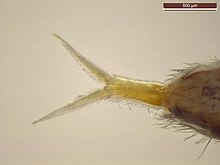38:
89:
Although the action of the furcula is hard to predict, it is versatile. Even a springtail drifting on the surface tension of a layer of water often can jump successfully. Furthermore, the furcula is effective in environments typical of
Collembola; most predators of springtails are small and many have
85:
One reason not to use the furcula for general locomotion other than to escape threats, is that its action is very unpredictable; when the furcula is released, the springtail is sent tumbling through the air on a practically arbitrary trajectory, and lands almost randomly. That may have advantages in
116:
species that live on the brink of flowing fresh water. The absence of a furcula in such species commonly is explained as an adaptation to a way of life in which a jumping or flying organ might get the animals into trouble more often than it rescues them. Its loss presumably is analogous to the loss
78:, which in turn is located beneath the third abdominal segment. When the furcula escapes from retinaculum, it swings downwards and hits the substrate, propelling the springtail into the air. The animal does not use this mechanism for ordinary locomotion, but only for escaping from
128:
has a jump where the acceleration peaks were measured at 970 m / s², which corresponds to an acceleration of phenomenal 98.9 g (compared to 3.0 g for an astronaut during a space shuttle launch).
131:
During the jumps, some species can perform several tumbles making their orientation unpredictable at the time of landing, after which they have the ability to recover very quickly. The body of
70:
that lives in the upper soil layers where it is used for jumping to avoid predators. While at rest, it is retracted under the abdomen and held there by a structure variously called the
142:
In aquatic species, the mucron is often wider, more flattened in shape like a paddle, which allows it during jumps to be supported on the liquid without breaking the surface tension.
202:
175:
90:
little power of sight, so if the prey leaps in time, the chances are that from the hunter's point of view, it simply vanishes.
168:
Imms' General
Textbook of Entomology: Volume 1: Structure, Physiology and Development Volume 2: Classification and Biology
221:
135:(Entomobryomorph) remains relatively vertical with its head remaining at the top once during its jump, while the
191:
31:
37:
102:, have only a very short furcula. Some other species have no furcula at all; examples include the
171:
117:
of the ability to fly, such as is common among birds and insects inhabiting oceanic islands.
108:
86:
escaping some forms of attack, but is not of much use in adopting any particular route.
215:
113:
103:
139:(Poduromorph) jumps forward with its head down and their body rotating on an axis.
17:
98:
157:
Christian, E., 1978. The jump of the springtails. Naturwissenschaften 65:495-496.
124:
which has a length of less than 2 mm long, uses their furca to jump up to 16 cm.
71:
66:
57:
79:
61:
190:
Rempel, Jenny. The
Evolution of Flightlessness in Galápagos Insects.
75:
56:
is a forked, tail-like appendage. It is present in most species of
94:
36:
120:
The furca allows for distant jumps relative to the body length.
203:"Springtails - the furca - Jumping organ of springtails"
64:
segment. The organ most often is present in species of
60:, and in them it is attached ventrally to the fourth
93:Some species of Collembola, for instance in the
8:
150:
7:
27:Anatomical structure in springtails
25:
1:
238:
170:. Berlin: Springer. 1977.
29:
133:Lepidocyrtus paradoxus
45:
137:Hypogastrura socialis
40:
30:For other uses, see
18:Furcula (Collembola)
122:Entomobrya dorsalis
82:or severe stress.
222:Springtail anatomy
126:Sminthurus viridis
46:
104:intertidal marine
42:Orchesella cincta
16:(Redirected from
229:
207:
206:
199:
193:
188:
182:
181:
164:
158:
155:
109:Anurida maritima
21:
237:
236:
232:
231:
230:
228:
227:
226:
212:
211:
210:
201:
200:
196:
189:
185:
178:
166:
165:
161:
156:
152:
148:
35:
28:
23:
22:
15:
12:
11:
5:
235:
233:
225:
224:
214:
213:
209:
208:
194:
183:
176:
159:
149:
147:
144:
26:
24:
14:
13:
10:
9:
6:
4:
3:
2:
234:
223:
220:
219:
217:
204:
198:
195:
192:
187:
184:
179:
177:0-412-61390-5
173:
169:
163:
160:
154:
151:
145:
143:
140:
138:
134:
129:
127:
123:
118:
115:
111:
110:
105:
101:
100:
96:
91:
87:
83:
81:
77:
73:
69:
68:
63:
59:
55:
51:
43:
39:
33:
19:
197:
186:
167:
162:
153:
141:
136:
132:
130:
125:
121:
119:
107:
99:Hypogastrura
97:
92:
88:
84:
65:
53:
49:
47:
41:
72:retinaculum
58:springtails
146:References
67:Collembola
112:and some
80:predators
62:abdominal
216:Category
114:riparian
106:species
50:furcula
44:, furca
174:
76:hamula
95:genus
54:furca
52:, or
32:Furca
172:ISBN
48:The
74:or
218::
205:.
180:.
34:.
20:)
Text is available under the Creative Commons Attribution-ShareAlike License. Additional terms may apply.
